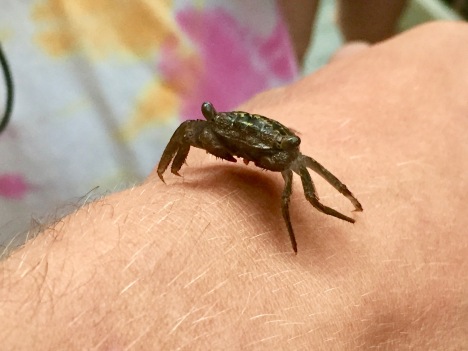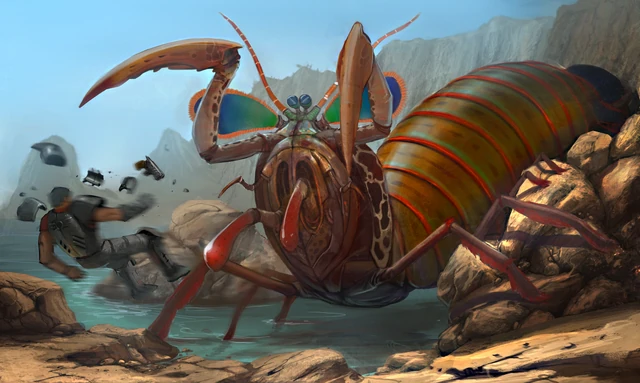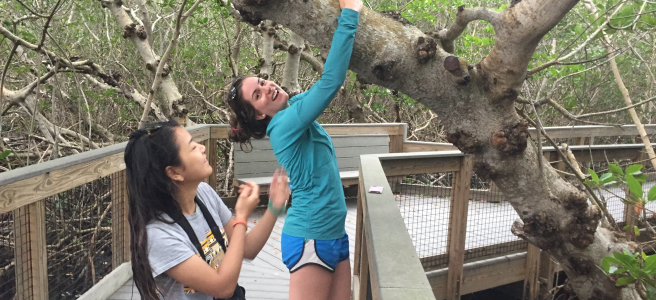Listen up. I know you’re sick of men. Of the “nice guys” and even the nice guys. Too forward. Too timid. Commitment-phobic. Clingy.
News flash:
The only man you need is mangroves.

Before you point out, “Hey, Plant Humorist, aren’t mangroves trees-”

Here are 6 facts that will convince you that mangroves are much better than men:
1. Mangroves don’t get salty.
Unlike a man, who may feel threatened if you’re a high achiever, or angry when you skip out on his “important” plans to hang out with your friends, a mangrove never gets salty!
Here’s a picture of a black mangrove (Avicennia germinans) exuding salt out of its leaves:

Wow, that mangrove really keeps its internal salt concentration low! Especially considering that it lives in an environment where the salt concentration can exceed 90 parts per thousand.
Now check out this pic of a red mangrove growing new prop roots. The roots are lined with extra suberin to exclude salt once they reach the water.

Wow, very little salt can get into those roots! What an un-salty plant.
2. Mangroves are hip and international.
Some men don’t understand travel.

Mangroves, on the other hand, live all around the world!

Look at that widespread distribution along the world’s tropical coasts.

So cultured!
3. Mangroves help others
Men can be selfish.

Mangroves, on the other hand, are the O.G. giving tree.

In Florida alone, mangrove forests shelter at least 220 fish species, 24 reptile species, 18 mammal species, and 181 bird species.
And they even host tiny mangrove crabs!
Look at this picture of a tiny crab and tell me that mangroves aren’t bae.

(Mangroves are bae.)
4. Mangroves have a high net worth
Men feel pressure to provide, in a lot of ways- and sometimes they talk a big game with a skinny wallet.
Mangroves, though, bring in the dough.

About 75% of game fish and 90% of commercial fish in South Florida depend on mangrove forest during their life cycle.
Mangroves also help prevent coastal erosion and protect against storms, saving millions of dollars. Ka-ching!
5. Mangrove wood.

Enough said*.
And, finally:
6. Mangroves will never leave you.
A man may leave you.
Although mangroves with prop roots are sometimes called “walking trees”, they are actually completely stationary after their viviparous shoot has implanted in the silty muck of the mangrove forest.
A mangrove will never leave you. It can never go anywhere!
Given this ~ extensive ~ evidence for why mangroves are superior to men, I hope you’re inspired to embrace mangroves in your life. Figuratively or, uh, literally.

So, the next time you have boy problems, remember:
Men are imperfect.
Mangroves are coastal trees growing in saltwater.

Footnote:
*Not enough said, actually: mangrove deforestation is a real problem! Shrimp farming and other threats have caused large-scale destruction of this important habitat.

While the sustainable harvest of mangrove wood is fine, people need to make sure to preserve mangrove forests for the valuable ecosystem services and wildlife habitat that they provide. And because mangroves are bae.
Sources & Further Reading:
Bester, Cathleen. “Mangrove Adaptations: Morphological and Physiological”. Florida Museum of Natural History. University of Florida, 2018. Web. <https://www.floridamuseum.ufl.edu/southflorida/habitats/mangroves/adaptations/>
Boonratana, Ramesh. “Mangrove Forests & Vivipary”. Youtube. Web. <https://www.youtube.com/watch?v=1EXSWc9d1WY>
Hill, K. “Mangrove Habitats”. Indian River Lagoon Species Inventory. Smithsonian Marine Station at Fort Pierce, 2009. Web. <https://www.sms.si.edu/IRLSpec/Mangroves.htm>
Lugo, A.E., Snedaker, S.C. 1974. The Ecology of Mangroves. Annu. Rev. Ecol. Syst. 5: 39-64.
“Mangrove Life.” Florida Museum of Natural History, 2018. Web. <https://www.floridamuseum.ufl.edu/southflorida/habitats/mangroves/mangrove-life>
“Mangroves”. J.N. “Ding” Darling National Wildlife Refuge, 2006. Web. <https://www.fws.gov/dingdarling/pdf/mangrove_brochure_2006.pdf>
Marsh, Alex G. and Leni L. Bane. Life Along the Mangrove Shore. Hobe Sound: Florida Classics Library, 1995. Print.
Warne, Kennedy. Let Them Eat Shrimp. Washington, D.C.: Island Press, 2013. Print.
Woodroffe, C., 1992. Mangrove Sediments and Geomorphology. Coastal and Estuarine Studies 41: 7-41.
Picture Credits:
salty leaf, mangrove wood, evil shrimp
Special thanks to the excellent models/ mangrove lovers of FFC18.

